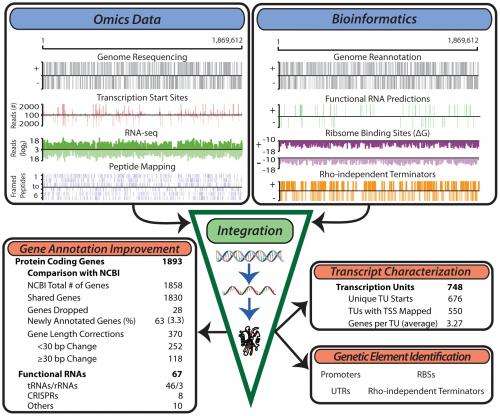Genome organization of organism reflects its 'hot' lifestyle

(Phys.org) —Microbial genomes have incredible functional and regulatory complexity, making them of great interest for potential environmental, energy, health, and industrial applications. In a study published in PLoS Genetics, scientists at the University of California, San Diego (UCSD) and Pacific Northwest National Laboratory (PNNL) used an integrated bioinformatics and multi-omics approach to characterize the genome organization of Thermotoga maritima, a bacterium that grows at temperatures between 131-194°F. Their approach revealed organizational features within the genome that lead to and regulate protein expression.
The scientists found that the genome organization of T. maritima reflects its lifestyle, with respect to both its extreme growth temperature and compact (1.86 Mb) genome. Notably, the extensive proteome coverage-74% of the bacterium's potential proteins-were observed, resulting in substantial revisions to the genome annotation. Sixty-six new proteins were discovered, and 32% of 369 gene length discrepancies were revised using the proteomics data.
These results indicate that T. maritima has very little transcriptional and post-transcriptional regulation. While the scope of this study is limited to a single organism, the hyperthermophilic nature of T. maritima makes it relevant to understanding the factors guiding microbial evolution and enhances the potential utility of the organism for biotechnology applications, such as high-temperature, biologically based chemical production.
Hydrothermal vents, where many of the Thermotogales thrive, have been proposed as sites where life on Earth began. Organisms in these vents are thought to potentially harbor traits of early microorganisms. Applying the integrated 'pan-omic' approach developed by the UCSD/PNNL team to T. maritima produced a valuable resource for the research community, which includes improved and expanded gene annotation, identification of novel genes and transcripts, and definition of sequence features that are associated with the execution of gene expression. Furthermore, the revealed genomic features of T. maritima can be studied in the context of its constrained lifestyle.
While this framework for studying genome organization can be applied to any microbial system, T. maritima provided an opportunity to examine the potential impact of hyperthermophilic growth conditions on sequence features required for macromolecular synthesis. The habitat where T. maritima thrives is reminiscent of the highly restrictive conditions on early Earth. It is hypothesized that genome organizational complexity and physicochemical constraints severely limited ancient organisms, causing them to exhibit relatively simple and less-diverse functional states. Scientists think that as the physicochemical burdens placed on these organisms lessened, the flexibility of genome organization increased, allowing the diversity of phenotypes seen today.
Continued study of the highly diverse Thermotogales using the UCSD/PNNL approach could resolve the phylogenetic trajectory of this order. Once many more genomes from diverse taxa are characterized, it is expected that scientists can more confidently resolve the impact of various selection pressures on genome organization.
The research team generated multiple genome-scale data sets and integrated them with bioinformatics predictions to reveal the genome organization. Omics approaches included genome resequencing, transcriptomics, RNA-seq, and liquid chromatography-tandem mass spectrometry (LC-MS/MS) peptide mapping. Bioinformatics approaches included genome re-annotation, functional RNA prediction, ribosome binding site energy calculations, and determination of intrinsic terminators. This multifaceted approach resulted in improved gene annotation, transcriptome and proteome characterization, and genetic element identification.
The integrated data sets provide more comprehensive knowledge that can greatly improve predictive modeling. The next step for this research involves bioengineering this organism for production of bioenergy, carbon sequestration, or even pharmaceutical applications.
More information: Latif, H. et al. 2013. The Genome Organization of Thermotoga Maritima Reflects Its Lifestyle, PLoS Genetics 9(4):e1003485. DOI: 10.1371/journal.pgen.1003485.
Journal information: PLoS Genetics
Provided by Pacific Northwest National Laboratory

















